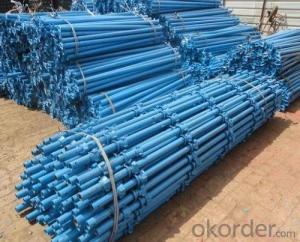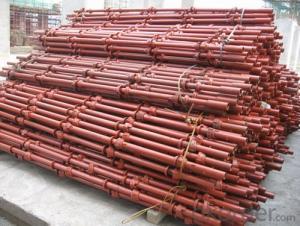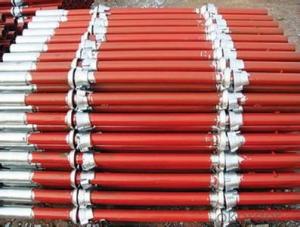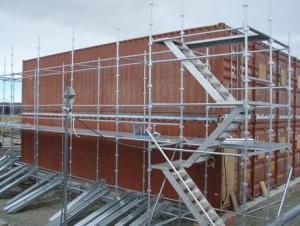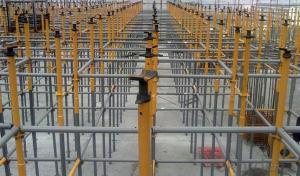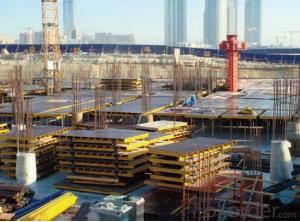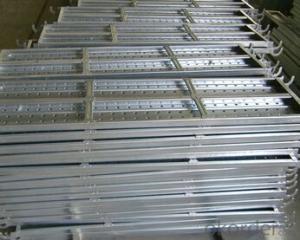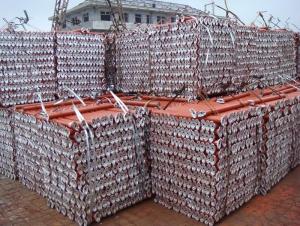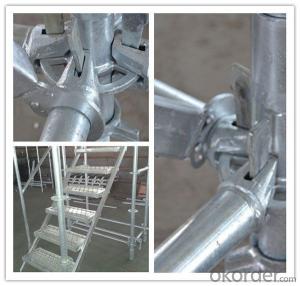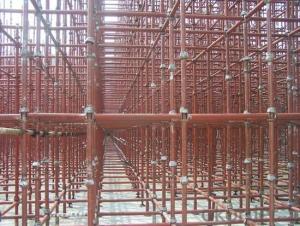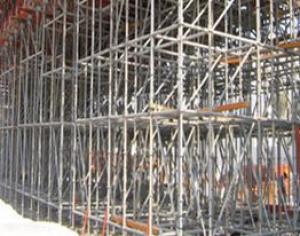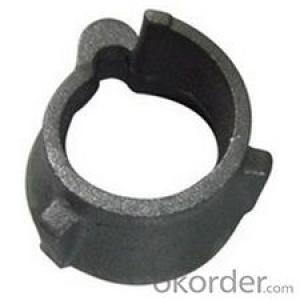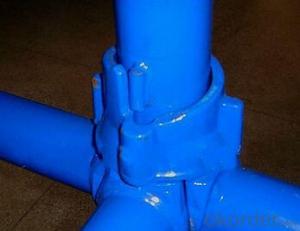Cuplock Scaffolding with Large Bearing Capacity Cuplock System
- Loading Port:
- Tianjin
- Payment Terms:
- TT OR LC
- Min Order Qty:
- 600 pc
- Supply Capability:
- 30000000 pc/month
OKorder Service Pledge
OKorder Financial Service
You Might Also Like
1.Structure of Cup-lock Scaffolding:
Size:
Standard Ø48.3×3.25 Q345 | Ledger Ø48.3×3.25 Q235 | Diagonal Ø48.3×3.25 Q235 | |||
Size/mm | Weight/kg | Size/mm | Weight/kg | Size/mm | Weight/kg |
500 | 3.45 | 600 | 2.54 | 1300×2000 | 9.21 |
1000 | 5.58 | 900 | 3.60 | 1800×2000 | 10.31 |
1300 | 7.97 | 1000 | 4.10 | 2500×2000 | 12.16 |
1500 | 8.74 | 1200 | 4.70 | 2500×2000 | 12.5 |
1800 | 10.60 | 1250 | 5.00 | 2500×2000 | 13 |
2000 | 11.38 | 1300 | 5.20 | 2500×2200 | 12.7 |
2500 | 14.00 | 1600 | 6.30 | 2600×2000 | 12.9 |
3000 | 16.63 | 1800 | 7.00 | 1300×2700 | 13.1 |
| 3000 | 17 | 2500 | 9.54 | 1300×2500 | 12.8 |
2. Main Features of Cup-lock Scaffolding:
1.Simple structure: The main parts include the standard, ledger and brace, it's easy to assemble and disassemble, and also easy to storage, transfer and maintain.
2.Safety and Steady: The up cup has the screw friction and self-gravity, it could self-lock steady, this makes the ledger steady, the loading of the ledger could transfer to the standard through the down cup, even the up cup is loose, the ledger joint could connect with the standard steady.
3.Multi using: According to the specific construction, Cup Lock Scaffolding could be assembled into one or two row with different size, it could also be used for multi construction tools, such as supporting frame, supporting column, materials lifting frame, stage supporting, etc.
3.Pictures of Cup-lock Scaffolding:
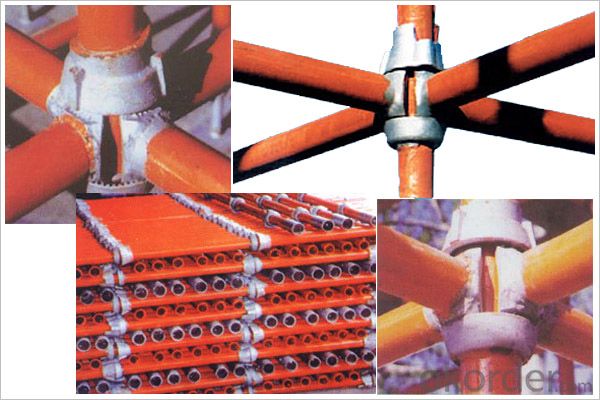
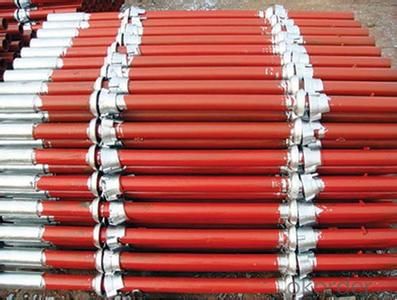
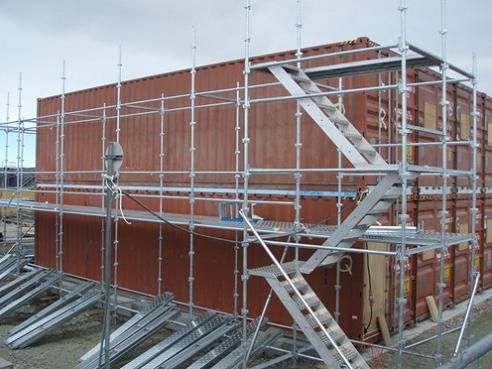
4. Cup-lock Scaffolding Specification:
The board ends are protected either by metal plates called hoop irons or sometimes nail plates, which often have the company name stamped into them. Timber scaffold boards in the UK should comply with the requirements of BS2482.
According to the specific construction, Cup Lock Scaffolding could be assembled into one or two row with different size, it could also be used for multi construction tools, such as supporting frame, supporting column, materials lifting frame, stage supporting, etc.
5. FAQ of Ring-lock Scaffolding:
Consent Authority (BCA) for the issue of a Building Consent or a Code Compliance Certificate in relation to the Building Act 2004, as well as these Best Practice Guidelines, should be considered to ensure that all practicable steps are taken to assure the safety of the structures and of end users.
The base collar with rosette together with the height-adjustable base plate forms the scaffolding base. The vertical standard is then placed into the base collar for further construction.
- Q:What is the difference between the bowl buckle steel tube scaffold and the steel pipe scaffold
- (3) the use of strong: the main components are the use of ordinary fastener type steel pipe scaffolding, steel pipe can be used to connect fasteners, universal.(4) the bearing capacity is large: the vertical rod connection is a coaxial core socket, and the cross bar is connected with the vertical rod by a bowl buckle joint. And the axial line of each member is placed at one point, and the node is in the plane of the frame. (the entire frame bearing capacity, about the same clear fastener type steel tube scaffold condition is improved by more than 15%,)
- Q:Bowl buckle scaffold from the machine to pull out the upper and lower bowl
- It seems that there is no specific load value in the code, but there are some requirements on the calculation method and some structural loads
- Q:What are the requirements for fastener type scaffolding? How to calculate
- 3, in order to ensure the safety of the scaffolding construction, scaffold should have enough strength, stiffness and stability. ?4, the use of scaffolding must be set along the outer wall of the safety net, to prevent falling material and high altitude operators fall
- Q:Bowl buckle scaffold is the whole force or local force
- Therefore, it has no bearing capacity and stability of the scaffolding
- Q:the shop said i might have the wrong ear shape, does anyone know of any pictures or diagrams of the wrong shape so i can see. Also what are some do's and do not's. not like cleaning cos i've read loads of them, just anything else useful. thankssharotoxxx
- Hello You should have asked them I dunno whats that mean the wrong ear shape But you can always do a cartilage piercing, it looks a way better Good luck
- Q:The height and spacing of the horizontal web of the scaffold?
- 1 horizontal horizontal bar should be set in the vertical horizontal bar and the vertical pole intersect the main node, both ends and the large cross bar fixed;2) the laying of the floor of the operating board should be increased to set the small cross bar;3) single row horizontal horizontal bar inserted into the wall should be greater than 18cm.
- Q:Buckle scaffolding problem, now used more or less? Why don't we use it?
- We're all talking about wooden scaffolding! But also very easy to use ah
- Q:why the scaffold nned to be inspected within the preceding seven(7) days?
- To make sure that it is constructed properly and things haven';t slipped out
- Q:can I claim compensation for falling of scaffolding and breaking my arm?
- If you can prove that the company was responsible i.e. the scaffolding was not safe, then yes. If it is proved that you ignored instructions, signage preventing your access or training, then no. The company cannot be held responsible for your stupidity, if for example, you decided to climb over a guardrail rather than leave the scaffold at the proper access points. In this case, you would get nowhere with a claim. If the scaffold was missing guardrails where it should have them, then quite rightly the company in charge of the site on which the scaffold is erected is responsible.
- Q:I have had a scaffold piercing since october last year(2012) and I don't think it's healing very well I clean it 2-3 times a day and twist it every now and again but it just keeps going red and saw I'd there anything I shoud do (btw I'm 14 and I live in the UK near London area?)And neither do I have keloids and it also scabs up a little still and hurt and burns, I use salt and water in a mug and clean with cotton buds.
- Scaffold is a cartilage piercing and cartilage piercings need 1 full year to fully heal if treated properly for the whole healing period. They are nothing like other piercings, they are not easy to heal and they have their ups and downs while doing so. They can stay irritated, swollen and painful for long, bumps can be formed around them which also can get infected. All this goes away after proper care but can happen again days or even months later. So you need to be extra careful with it and follow your piercers after care instructions by the book if you want to keep yourself and the piercing healthy. You need to do sea salt soaks 2 times a day for the whole healing period and never stop. How to do : Warm water (8oz) + non iodized salt (1/4 teaspoon) mixed in a cup. Soak the piercing in for 10 minutes, 2 times a day. Use a q-tip to clean around the piercing thoroughly, rinse with water and pat it dry with a paper towel. Until the piercing is fully healed don't : Touch it, twist the jewelry, play with it, sleep on it, change the jewelry or take it out but only touch it with freshly washed hands to clean it. Do not twist the jewelry. If a piercing is freshly cleaned it can easily slide in and out with the slightest push. Some kids mistakenly think that if you don't twist the jewelry it will somehow get stuck to the skin and never move again. This is a bad myth and can never happen. If you keep twisting the jewelry the crusties that are naturally created and attacked to the jewelry will keep scratching the inside part of the piercing ( the actual wound ) causing trauma again and again, irritating the piercing and dealing the healing process. A new piercing , especially cartilage ones need cleaning, time to heal and avoid touching.
1. Manufacturer Overview |
|
|---|---|
| Location | |
| Year Established | |
| Annual Output Value | |
| Main Markets | |
| Company Certifications | |
2. Manufacturer Certificates |
|
|---|---|
| a) Certification Name | |
| Range | |
| Reference | |
| Validity Period | |
3. Manufacturer Capability |
|
|---|---|
| a)Trade Capacity | |
| Nearest Port | |
| Export Percentage | |
| No.of Employees in Trade Department | |
| Language Spoken: | |
| b)Factory Information | |
| Factory Size: | |
| No. of Production Lines | |
| Contract Manufacturing | |
| Product Price Range | |
Send your message to us
Cuplock Scaffolding with Large Bearing Capacity Cuplock System
- Loading Port:
- Tianjin
- Payment Terms:
- TT OR LC
- Min Order Qty:
- 600 pc
- Supply Capability:
- 30000000 pc/month
OKorder Service Pledge
OKorder Financial Service
Similar products
New products
Hot products
Hot Searches
Related keywords
